BUSINESS
SEMA Announces First-Ever Emissions Certification Program
The New Initiative Meets EPA Tampering Policy Requirements to Help Speed Products to Market
By Mike Imlay
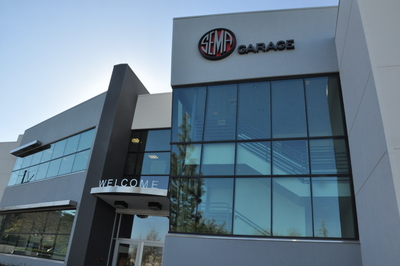
For nearly a decade, the SEMA Garage has assisted association members in obtaining CARB EOs. Now a new SEMA Certified-Emissions (SC-E) program is helping manufacturers demonstrate “49-state legality” for their products under EPA guidelines. For many, this means quicker speed to market.
In February, SEMA announced an industry first: a new program making it possible for specialty automotive parts manufacturers to meet the legal requirement for emissions compliance under the U.S. Environmental Protection Agency’s (EPA) Tampering Policy. The program, called SEMA Certified-Emissions (SC-E), enables manufacturers to verify that a product meets the EPA’s “reasonable basis” criteria and is therefore legal for sale in 49 states.
According to Mike Spagnola, SEMA vice president of OEM and product development programs, SC-E now gives product makers “a clear, accelerated path to compliance so they can begin selling products legally in 49 states prior to receiving a California Air Resources Board (CARB) Executive Order (EO), which remains a requirement for selling products in all 50 states.”
Ultimately, SC-E aims to help manufacturers more quickly speed products to market while paving a path for demonstrating emissions compliance in all 50 states. For the inside scoop on this new program, SEMA News turned to Peter Treydte, SEMA director of emissions compliance, and David Goch, SEMA general counsel, for a brief Q&A. The following is that interview, edited for clarity and length.
SEMA News: Let’s start with some background. Why did SEMA launch the SC-E program?
Peter Treydte: Until recently, the CARB EO was really the only known path toward clear emissions compliance in all 50 states. If you followed that program and obtained an EO, the EPA always recognized it as a proper demonstration of emissions compliance. What remained unclear until recently was the path to emissions legality in 49 states without a CARB EO. Companies realized they needed to demonstrate a “reasonable basis” to claim 49-state legality, but they didn’t know how to get there.
In November 2020, the EPA clarified what constitutes a reasonable basis in its Tampering Policy. Now that we have clear guidance, SEMA is leveraging that document to provide a program that can give manufacturers assurance that their products are 49-state legal. They can become EPA-compliant through SEMA certification.
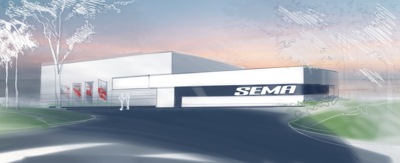
Work is continuing on the new 45,000 sq. ft. SEMA Garage facility in Detroit, pictured in this artist rendering. The Detroit location’s new emissions lab is expected to open this summer, bringing substantially expanded testing capabilities to the SC-E program.
David Goch: Members also need to know that this is about more than compliance. This is about enforcement. The Clean Air Act and CARB mandates have been in place for half a century, but there wasn’t strong enforcement during much of that time. Now it’s different. We aren’t dealing with the EPA or CARB of the ’70s, ’80s or ’90s. Aggressive enforcement is now taking place. Moreover, EPA and CARB enforcement techniques—the fines they are leveling and the consent agreements they are having parties enter into—are difficult and onerous. We’re trying to help the industry stay compliant and avoid all that.
SN: How does SC-E lessen the risk of the severe business disruptions you describe?
DG: If the EPA knocks on your door thinking that you’re doing something illegal, you’re in for a long road. You’ll have to produce information about your sales, customers, and all sorts of other documents. You’ll spend a lot of time and money on that, not to mention legal bills and civil enforcement. But if you can pull out your SEMA certification, we’re confident the EPA will say, “Fine, thank you,” and accept it as evidence that your product is legitimate. Hopefully, the EPA never knocks, but if it does, this will be the best way to quickly end the conversation.
SN: How does a manufacturer access the program?
PT: It starts by contacting the SEMA Garage. We’ll assist the manufacturer with the application process, which includes a product description, what it fits and so forth. There is a $500 fee to submit the application.
In processing the application, we’ll determine and advise whether any testing is necessary and what that testing will be. If it’s testing available at either our Diamond Bar or Detroit SEMA Garage facilities, we’ll perform it. If not, we’ll help guide the project through an appropriate outside testing facility.
I should add that the program is already active. We completed our first project earlier this year, and we have another seven or eight projects in the hopper that will be certified within a month or so.
SN: What are the nuts and bolts of the testing process?
PT: Functionally, it’s going to feel very similar to a CARB EO process. However, we aim to be faster than CARB is at issuing EOs. It can take CARB up to six months to issue an EO. Since we’re certifying EPA compliance, we also have a little more flexibility than CARB in certain areas. Still, the idea is that if you’re also intent on receiving a CARB EO, we’ll tailor your project to meet both the EPA and CARB requirements.
In other words, you can obtain an SC-E certificate followed by a CARB EO. In most cases, the SC-E certificate will be in your hand a month or more ahead of the CARB EO, enabling you to confidently market your products in 49 states sooner than in California. But ultimately, our testing will be in the same format CARB requires. We’re simply leveraging what we already know about the CARB process for our SC-E program.
DG: Just to emphasize what Peter said, SEMA believes that its program is equivalent to a CARB EO. In time, we’ll be able to demonstrate that. Our goal goes beyond EPA compliance. We plan to work with other state and local agencies concerned with vehicle emissions standards to secure their recognition of our SC-E program as well.
What’s exciting about this is that it’s SEMA’s first foray into assisting the aftermarket and performance racing industries with a standards and certification program. We anticipate that it will be successful and become a template for any future programs addressing other segments of our industry. In fact, this resembles the self-regulation found in many industries. When they need clarity in a particular area, they find ways to set and meet standards and promote their products in a legal manner.
SN: Like the Underwriters Laboratories (UL) label for electric products?
PT: That’s a good example. In fact, along with an official certificate and seal, we’ve developed a label that can be affixed to products or packaging.
SN: Many association members are probably familiar with the testing process at the SEMA Garage, but just as a refresher, what’s involved?
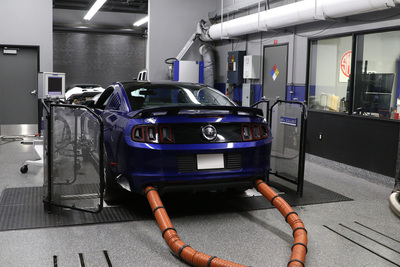
With a new emissions lab in Detroit and this one in Diamond Bar, California, the SEMA Garage has full, state-of-the-art OBD and tailpipe-emissions testing capabilities, covering well over 90% of product applications. For outlier projects, an SC-E engineer can determine and direct the right testing at an outside facility.
PT: There are generally three aspects to emissions evaluation. First, there’s an evaluation of the onboard diagnostic system (OBD), which is fairly self-explanatory. We basically look at the vehicle’s ability to diagnose itself and ensure that all the emissions equipment is working properly. Whenever you’re dealing with an aftermarket product that involves emissions, you have to make sure the OBD system remains functional.
The second aspect is tailpipe emissions, or what the vehicle produces while it’s running. The third is evaporative emissions. That’s what’s coming off the vehicle when it’s not running. At the SEMA Garage, we directly evaluate the first two—OBD and tailpipe emissions. Between our two lab locations, those comprise well over 90% of the cases that come to us.
Evaporative emissions testing is a little more nebulous at the moment. Our industry hasn’t had to do as much of it in the past, so SEMA doesn’t currently have that capability. However, it’s an area where we would cooperate with other laboratories that do. In such cases, we would establish the testing parameters to obtain the required data.
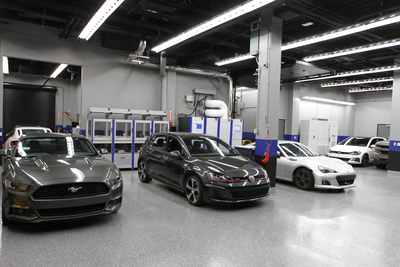
Vehicles carrying SEMA-member products acclimate as they await emissions testing at the SEMA Garage in Diamond Bar, California. SEMA’s emissions compliance program has been groundbreaking for manufacturers in developing products that embody today’s clean-air standards.
SN: What about staffing? We imagine that’s a consideration in launching the new SC-E program.
PT: Yes, definitely. Our emissions compliance center already has an experienced staff that has been assisting members with CARB EOs for the past eight years. We’ll continue to leverage that staff for SC-E because the work is comparable to what it’s currently doing. In addition to that, we’ll expand our engineering staffing, which will be principally responsible for evaluating a product, examining the test data, and writing up or documenting the justification for the certification. So there will be added staff behind the scenes, so to speak.
SN: Can you help us picture that documentation? What will it look like and where will it reside?
PT: We’ll produce an official, two-page document that will be all locked down and available via our website and in printable form. The certificate will include a description of the product and everything pertaining to its certification that anyone who’s interested needs to know.
In addition, the member company will also receive a test report to keep in its possession. This report won’t be made available to the public. The applicant or manufacturer can share it however it chooses, but it’s really intended for EPA purposes. If the EPA has any questions, a company can whip out this report to demonstrate the reasonable basis for its product’s compliance. It provides all the justification that’s necessary.
Finally, we’ll have a small label available that a manufacturer can ship with its product. That will carry basic information about the certification. It will also have a QR code so that any technician who’s doing a smog check can scan it and see the public certification document on our website. This way, a manufacturer’s customers can also have confidence in the products they install on their vehicles.
SN: It seems this program covers all the bases. Before we wrap up, are there any closing thoughts you’d like to emphasize?
DG: I would underscore—and you’ve probably already picked this up as a theme—that SEMA is addressing the changing emissions landscape. The fact is that enforcement against our industry is now a way of life. Manufacturers and companies that want to continue in the performance parts arena have to recognize this reality.
SEMA is here to help, and we’re creating a pain-free program to do so. It’s not like dealing with the government but rather our outreach to SEMA members to give them the certainty they desire. It offers the ability to go to market pretty much as quickly as their R&D allows. That’s our goal here.
PT: I also like to characterize SC-E in terms of its benefits to our members. Dave just mentioned the faster path to market and, really, a faster path to a compliance demonstration. A second benefit is that we’re providing clarity for the industry on what constitutes “reasonable basis” for the EPA. That’s been ambiguous up until now. EPA documentation offered guidance but didn’t provide a path.
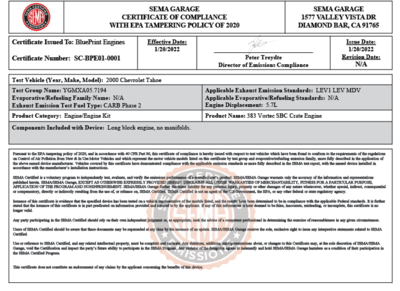
BluePrint Engines was among the first SEMA-member companies to secure a SEMA Certified-Emissions certificate. Manufacturers that pass certification receive both public documentation and a detailed private report that they can present to regulatory officials as needed.
The EPA doesn’t have its own certification program, so we’re basically creating one for the industry. It will deliver credence to a claim of EPA compliance and the term “49-state legal.” In the past, that terminology has sometimes been very loosely applied or even misused. We’re clearing up the situation.
Finally, there will be some product types that simply won’t fit the CARB EO program. Our program will provide a path to emissions compliance for those products as well.
 SEMA Certified-Emissions (SC-E) Fast Facts
SEMA Certified-Emissions (SC-E) Fast Facts
- Since 2014, the SEMA Garage has been instrumental in helping automotive aftermarket parts manufacturers obtain California Air Resources Board Executive Orders.
- With state-of-the-art, CARB-recognized testing equipment and dedicated expert staff conducting tests and assisting with the process, the SEMA Garage has helped association members secure more than 500 CARB EOs. That represents more than half of all performance-parts EOs issued by CARB.
- The new SC-E program is comparable to CARB EO requirements and was developed in response to the EPA’s Tampering Policy.
- Members of SEMA staff are experts in assessing a manufacturer’s needs and advising the most appropriate path forward, including whether to apply for a CARB EO or SEMA emissions certification.
- The SC-E program may help manufacturers get their products to market about three months before obtaining a CARB EO.
- SC-E is also ideal for products that may not have a clear path in the CARB EO process (such as flex-fuel modifications, HCT-equipped intakes and engine packages).






